

Holy Cross Latin Course. Learning the Office Part XIII: Tackling the Latin! The first part of this series can be found here.
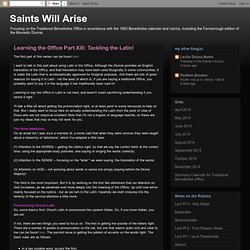
I want to talk in this part about using Latin in the Office. Although the Diurnal provides an English translation of the Office, and that translation may have been used liturgically in some communities, it is really the Latin that is ecclesiastically approved for liturgical purposes. And there are lots of good reasons for saying it in Latin - not the least of which is, if you are saying a traditional Office, you probably want to say it in the language it has traditionally been said in!
Learning to say the Office in Latin is not hard, and doesn't mean sacrificing understanding if you tackle it right. I'll talk a little bit about getting the pronunciation right, or at least point to some resources to help on that. The three attentions On an email list I was once a member of, a monk said that when they were novices they were taught about a hierarchy of 'attentions', which I've adapted a little here: The Ablative Case in Latin - Detail.
Latin Pronunciation. Pronouncing Church Latin (mp3) The Principal Prayers in Latin. In Nomine Patris In nómine Patris, et Fílii, et Spíritus Sancti.
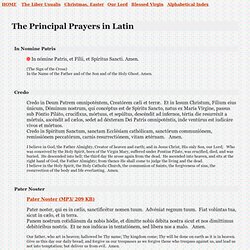
Amen. More Latin Prayers. Fr. Z’s PODCAzT Page. Fr.

Z's Blog Once named: What Does The Prayer Really Say? – Commentary on Catholic issues & slavishly accurate liturgical translations – by Fr. John Zuhlsdorf o{]:¬) Skip to content Fr. My humble offerings and rants. My feed is HERE. 138 13-12-24 Christmas Poetry Experiment 137 13-09-22 Augustine on bad pastors; Sermon in the wake of Pope Francis’ interview136 13-07-19 John XXIII opens Vatican II – ‘Gaudet Mater Ecclesia’ – optimism and naïveté, error and continuity135 13-07-07 Encyclical Letter “Lumen fidei” – AUDIO of encyclical. The Chant of Le Barroux. Learning the New Breviary - Biretta Books. Learning the New Breviary "The Divine Office is an essential part of the liturgical day.
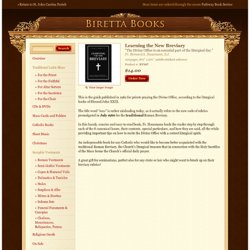
" Fr. Bernard A. Hausmann, S.J. 120 pages, 8½" x 5½", saddle-stitched softcover Product #: SY347 View larger image This is the guide published in 1962 for priests praying the Divine Office, according to the liturgical books of Blessed John XXIII. Latin Mass Society. SanctaMissa.org. Little Paraklesis. The Book of Common Prayer: Its Origin and Growth, by JH Benton. WHEN the supremacy of the Roman See in matters of faith was destroyed in England, and the supremacy of the King established in such matters, it became necessary that articles of Christian belief should be promulgated by the head of the English Church.
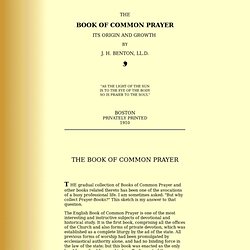
Such articles were drawn up and adopted by the Convocation in July, 1536. They were then established by royal proclamation as "Articles devised to stablish Christian quietness and unity among us and to avoid contentious opinions. " The Ordo Calendar on www.CommonPrayer.org. A New History of the Book of Common Prayer. The Book of Common Prayer. The Liturgical Year by Dom Guéranger - Advent. During Advent, the Christian, on awaking in the morning, will unite himself with the Church, who, in her Office of Matins, says to us these solemn words, which choirs of religious, men and women, throughout the universe, have been chanting during the deep silence of the night: He will profoundly adore this great King, whose coming is so near at hand: and with this idea deeply impressed upon his mind, he will perform the first acts of religion, both interior and exterior, wherewith he begins the day.
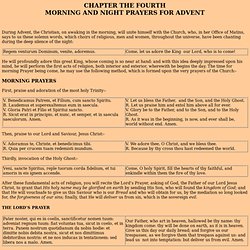
Lent Today. Galería: Vestuario Católico. Es una vestidura en forma de túnica, de color blanco y de corte simple.

Es el anillo que utiliza el obispo como signo de la labor que se le ha encomendado. Palo o cayado que termina en una bola o en una cruz y lo usan los obispos, pastores espirituales del pueblo. Sombrero de cuatro picos con una borla al centro utilizado anteriormente por los sacerdotes. Vestidura Sagrada que se pone el Sacerdote sobre la sotana, el alba y la estola y que sirve para celebrar la Misa. Está abierta por lo alto, para que entre la cabeza, y por los lados; cae por delante y por detrás desde los hombros hasta media pierna. Cordón o cinta de seda o de lino, con una borla a cada extremo, que le sirve al Sacerdote para ceñirse el alba. Es una túnica abierta por los lados y con mangas anchas, cortas y abiertas que usan los diáconos. Es la insignia sacerdotal, hecha a manera de una banda, de aproximadamente dos metros del largo que puede o no tener adornos y que se usa sobre el cuello y que cae hacia adelante.
Open Wednesday Home Page. Latin-English Propers for the Ordinary Form of Mass (WDTPRS)